|
The Māori tree name "karo" is probably home grown. However, since the possibility of its being related to Fijian qalo, and therefore of pre-Polynesian origin, is noted in the Pollex database, it merits a place in Te Māra Reo, even though the connection with the Fijian word, and possibly also a Samoan reduplicated form, 'alo'alo (a species of flame tree) is somewhat tenuous -- the plants do not have much in common apart from being trees, and there are no other "karo", "kalo" or "'alo" in East or West Polynesian languages. However, the name could simply have been lost elsewhere over the centuries, so we can give its possible whakapapa the benefit of the doubt.
 The link with the Samoan tree may be a little stronger than that with the Fijian qalo, because the Aotearoa karo does have glowing red flowers, not as large and spectacular as those of the flame tree, but glowing and visible from a distance nonetheless. This would probably be the result of convergent thinking, however, perhaps by people at different times and places seeing in the the flowers the reflection of the sunset's last glow on a distant horizon, rather than the deliberate reuse of a known inherited plant name. The link with the Samoan tree may be a little stronger than that with the Fijian qalo, because the Aotearoa karo does have glowing red flowers, not as large and spectacular as those of the flame tree, but glowing and visible from a distance nonetheless. This would probably be the result of convergent thinking, however, perhaps by people at different times and places seeing in the the flowers the reflection of the sunset's last glow on a distant horizon, rather than the deliberate reuse of a known inherited plant name.
The tropical trees are described and illustrated on their own page (link at the top of this one).
The natural habitat of this tree is on cliff-faces, rocks, along forest margins and streams nr the sea in the northern North Island, although it is now established in many other parts of New Zealand and also, according to Dawson and Lucas (New Zealand Native Trees) naturalized in Hawai'i and Norfolk Island. It grows to about 9 m high as a shrub or small tree with mostly erect branches and smooth, greyish-brown bark. The leaves are very thick and turned down near the margins, making this the best able of the Pittosporums to withstand salty winds. It is often planted as a shelter hedge, but can become invasive; its very hard and heavy wood makes it difficult and somewhat hazardous to trim if a hedge or shelter-belt is left unattended for a few years.
-LJ-CRW.jpg) The branchlets and undersides of the leaves are woolly. The leaves grow from 5 - 7 cm by 2 to 2.5 cm, tapering near the stalk and rounded at the tip. The flowers are a little over 1 cm wide with very bright or deep red petals. The flowers are pleasantly scented -- karo was described by J.T. Salmon (The Native Trees of New Zealand, p. 144) as "one of the most notable of New Zealand's scented plants". He observed that "during the flowering season, the air near karo trees is filled with a delightful fragrance". The blossoms are a good source of nectar for tui. The long flowering season lasts through Spring and Summer, followed by capsules (illustrated on the left) which are much relished by rats; when mature they split to reveal seeds (below, right) covered in mucilage and so easily transportable by birds. The seeds germinate readily, so in favourable situations the karo can form groves or (outside its natural environment) become an invasive nuisance. The rats however either chew the seeds or eat the capsules before the seeds mature, as the NZPCN fact sheet for karo notes that "on rodent infested offshore islands this species rarely regenerates". The branchlets and undersides of the leaves are woolly. The leaves grow from 5 - 7 cm by 2 to 2.5 cm, tapering near the stalk and rounded at the tip. The flowers are a little over 1 cm wide with very bright or deep red petals. The flowers are pleasantly scented -- karo was described by J.T. Salmon (The Native Trees of New Zealand, p. 144) as "one of the most notable of New Zealand's scented plants". He observed that "during the flowering season, the air near karo trees is filled with a delightful fragrance". The blossoms are a good source of nectar for tui. The long flowering season lasts through Spring and Summer, followed by capsules (illustrated on the left) which are much relished by rats; when mature they split to reveal seeds (below, right) covered in mucilage and so easily transportable by birds. The seeds germinate readily, so in favourable situations the karo can form groves or (outside its natural environment) become an invasive nuisance. The rats however either chew the seeds or eat the capsules before the seeds mature, as the NZPCN fact sheet for karo notes that "on rodent infested offshore islands this species rarely regenerates".
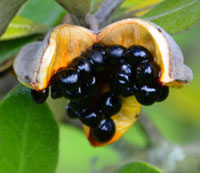 The tough, hard wood is not the best firewood: it is placed by the NZ Fire and Emergency service in second-lowest (low/moderate) of their five levels of flammability. Karo is sometimes referred to as the "turpentine tree". Turpentine may have been obtained from the gummy exudatefrom damaged bark; Rodney Weston (2004) studied the oils from the leaves of several species of Pittosporum, including P. crassifolium, but although all except tarata (P. eugenioides) had "turpentine-like aromas", the yields were probably too low to be of commercial significance. The oil fron tarata however "could be considered as the basis for a potentially unique New Zealand fragrance due to its 'lemon-like' aroma and significant cultural use for this purpose". Despite its fragrant flowers, the leaves of P. crassifolium did not have this quality. The tough, hard wood is not the best firewood: it is placed by the NZ Fire and Emergency service in second-lowest (low/moderate) of their five levels of flammability. Karo is sometimes referred to as the "turpentine tree". Turpentine may have been obtained from the gummy exudatefrom damaged bark; Rodney Weston (2004) studied the oils from the leaves of several species of Pittosporum, including P. crassifolium, but although all except tarata (P. eugenioides) had "turpentine-like aromas", the yields were probably too low to be of commercial significance. The oil fron tarata however "could be considered as the basis for a potentially unique New Zealand fragrance due to its 'lemon-like' aroma and significant cultural use for this purpose". Despite its fragrant flowers, the leaves of P. crassifolium did not have this quality.
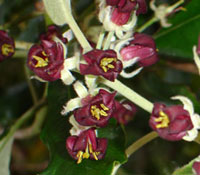 Both species of karo are endemic to Aotearoa. The other karo, Pittosporum ralphii, is a smaller tree than P. crassifolium, with spreading (rather than upright) branches, and growing to about 5 metres. Its leaves are longer than those of P. crassifolium (7.5 - 12 cm), with crinkly margins, but the fruit is only about half the size. However the flowers (illustrated on the left) are also bright red, about a centimetre wide. The tree is found naturally from East Cape to Wairarapa in the east of the North Island, and along the Patea and Wanganui Rivers in the southwest. Ironically, although it is recognized in the World Flora Online and Biota NZ databases, its Latin name may be a synonym of P. crassifolium (the description of the type specimen of P. ralphii seems to be identical with that for P. crassifolium), making it currently a species without a valid botanical name (see the NZPCN fact sheets for P. crassifolium and P. ralphii). Both species of karo are endemic to Aotearoa. The other karo, Pittosporum ralphii, is a smaller tree than P. crassifolium, with spreading (rather than upright) branches, and growing to about 5 metres. Its leaves are longer than those of P. crassifolium (7.5 - 12 cm), with crinkly margins, but the fruit is only about half the size. However the flowers (illustrated on the left) are also bright red, about a centimetre wide. The tree is found naturally from East Cape to Wairarapa in the east of the North Island, and along the Patea and Wanganui Rivers in the southwest. Ironically, although it is recognized in the World Flora Online and Biota NZ databases, its Latin name may be a synonym of P. crassifolium (the description of the type specimen of P. ralphii seems to be identical with that for P. crassifolium), making it currently a species without a valid botanical name (see the NZPCN fact sheets for P. crassifolium and P. ralphii).
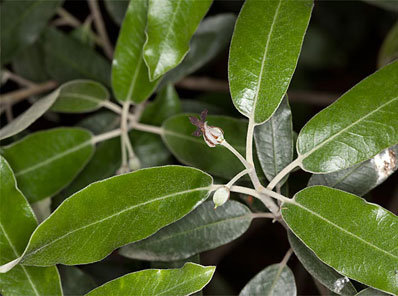
Pittosporum ralphii - Karo (with developing fruit)
(Kuripapango, Hawkes Bay. Photo (c) Mike Thorsen, NZPCN)
|
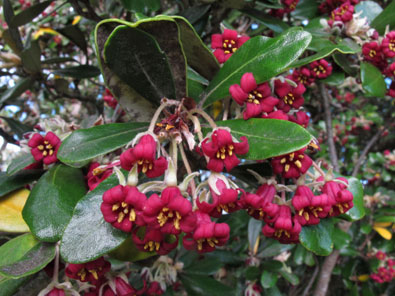
Pittosporum crassifolium - Karo
(Masterton. Photo: (c) John Barkla, NZPCN) |
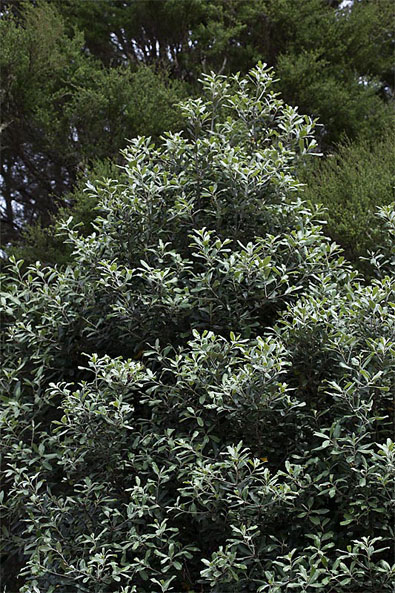
Pittosporum ralphii - Karo
(Kuripapango, Hawkes Bay. Photo: (c) Mike Thorsen, NZPCN)
|
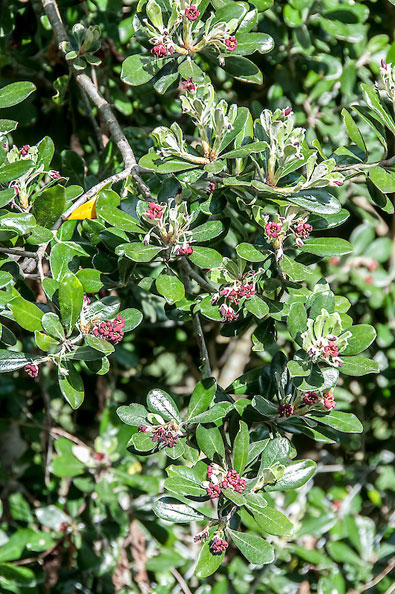
Pittosporum crassifolium - Karo (Flowering, in cultivation)
(Photo: (c) Jeremy Rolfe (NZPCN) |
|
Photographs: The inset photos are: [1] Sunset over Te Māra Reo, by Alan Benton; [2] Maturing fruit of Pittosporum crassifolium, by (c) Larry Jensen, University of Auckland; [3] Open mature fruit of P. crassifolium showing seeds, Meola Reef, Westmere, Auckland, by John Sawyer (c) NZPCN; and [4] Flowers of P. ralphii, by (c) Peter de Lange, NZPCN. The other photographs are acknowledged in the captions. We are grateful to all the photographers for permission to use their work.
Citation: This page may be cited as: R. A. Benton (2023) "Karo" (web page periodically updated), Te Mara Reo. "http://www.temarareo.org/TMR-Karo.html" (Date accessed)
(Hoki atu ki runga -- Go back to the top of the page.) |

